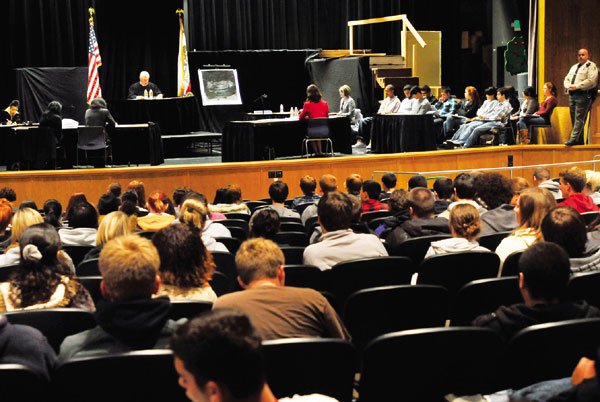Superior Court Judge Ronald Toff presided over a DUI trial in
the oddest of locations
– Live Oak High School’s theater. More than 300 seniors squirmed
and stretched their way through the four-hour court procession
Tuesday morning – and the teens’ curiosity was tangible during the
question-and-answer session after the verdict was read, most
derived from their own experiences with
alcohol and about the residual effects of drunken driving.
Superior Court Judge Ronald Toff presided over a DUI trial in the oddest of locations – Live Oak High School’s theater. More than 300 seniors squirmed and stretched their way through the four-hour court procession Tuesday morning – and the teens’ curiosity was tangible during the question-and-answer session after the verdict was read, most derived from their own experiences with alcohol and about the residual effects of drunken driving.
“I think it was a really good experience for everyone to see exactly – when you’re over 18 – the consequences of even a minor DUI like this lady was charged with,” said Jennifer Protsman, a Live Oak senior and member of the mock jury. “And I think it answered a lot of questions that people had about law enforcement and police conduct, how a judge bases his decisions.”
DUI Court in the Schools prevention program teaches students about the consequences of drinking and driving while witnessing first-hand the judicial process. Live Oak hosted the first trial in South County since Gilroy High School observed a DUI trial in 2002.
“In fact, from this point on this is no longer the auditorium on the campus of Live Oak High School. It is Department 105, Santa Clara County Superior Court,” Judge Toff said.
After two witnesses, an expert criminalist and the defendant testified, the jury was sent away to deliberate. Fifteen minutes later, the 12 seniors found San Jose resident Helen Spangler, 46, guilty of driving under the influence of alcohol on Nov. 22 when after leaving a bar in Mountain View she crashed her car near the Alameda in San Jose and was arrested about 3 a.m. after failing a sobriety test. Her blood alcohol level registered at 0.11 percent – above the 0.08 percent legal limit.
Judge Toff was pleased to hear that the student jury’s decision was identical to his. The jury was unanimous in its decision and said the guiding factor was Spangler’s illegal blood alcohol level.
Her $1,760 fine was reduced by $500 and the typical six-day jail sentence for a first-time DUI was thrown out because of the agreement among the district attorney, Spangler and her public defender to host the trial at Live Oak. She will also be on probation and have to attend a three-month alcohol treatment program.
“I think it’s really good for the kids. I hope it will deter kids from getting behind the wheel of a car,” Spangler said. “The reality is you have to pay the consequences, more than just monetary. There’s the stigma,” she said.
The leading cause of death for teens are car crashes and most involve alcohol. The DUI Court in Schools program is one strategy that aims to reduce alcohol-related crashes among teen drivers who are inexperienced in handling a car. In 2008, Santa Clara County saw 118 collisions involving drivers younger than 21 who had been drinking, according to the California Office of Traffic Safety.
During the court proceeding, students were attentive – five Morgan Hill police officers and two sheriff deputies ensured the audience behaved. Judge Toff facilitated the open dialogue, where no teen’s question was off-limits to Spangler, himself or any of the peace officers in the room.
“When you spun out and you hit the guardrail and you stopped, how come you called your friend and you didn’t call 911?” asked a senior student.
“You’re absolutely correct. And it was a wrong move on my part. I think I was just wigging out and who knows. To be honest with you, who knows why I made the decision I made. It was the wrong decision. Regardless if I had been drinking or not, I should have called 911,” Spangler said.
Curious and uncensored were other students who unintentionally lightened the mood of the courtroom with questions about how they could prevent police from entering their home if “in theory” there were a house party going on with alcohol flowing and underage participants, or what could happen if a sober driver is pulled over with a carload of underage, drunk buddies.
Protsman said she’s not heard of any Live Oak students who get behind the wheel of a car after drinking.
“Most people are really safe, they always choose a designated driver,” she said.














